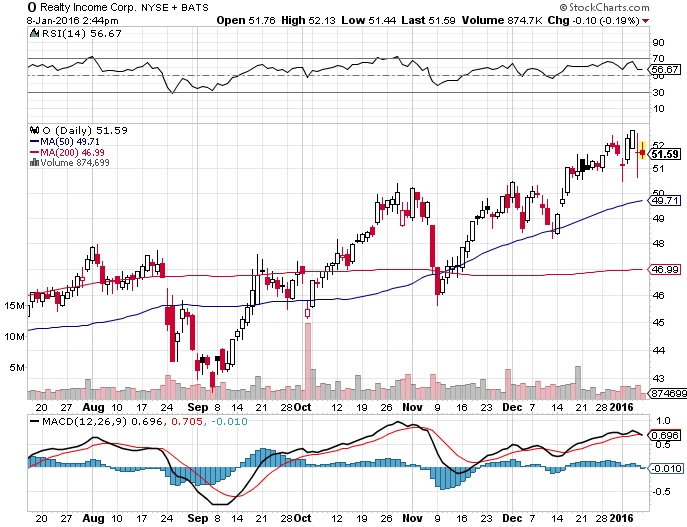Building a REIT Portfolio Brick by Brick
The worst week in history for the stock market has left the portfolios of millions of investors severely wounded and needing triage in the form of a repositioning of asset weighting. As the global market is more of an investing minefield right now than at any time in the past seven years, the safe haven of high-quality, U.S. dollar-based equities is rapidly being elevated to the go-to space for fund flows. Even better, domestic blue chip stocks in defensive businesses that are leveraged to consumer spending, and that pay out dividend yields in excess of 3.0%, are now particularly attractive.
One of the benefits, if you can call it that, of a week where the broad market resembles a slow motion train wreck, is that it reveals which select subsectors are not being abandoned in the “sell first ask questions later” rush to the exits. While literally all 11 sectors of the overall stock market came under varying degrees of selling pressure, there definitely was a noticeable shift into stocks of companies where the stable and strengthening consumer can be depended on.
Of the 11 market sectors, investors consider two defensive and the remaining nine cyclical. Defensive stocks include utilities and consumer staples. Those companies usually don’t suffer as much in a market downturn because people don’t stop consuming the basic products and services necessary for daily life. They provide balance to portfolios and protection in a falling market. Defensive stocks do exactly what their name implies, assuming they are well-run companies.
They give you a cushion for a soft landing in a falling market. Conversely, cyclical stocks cover everything else that tends to react to various economic conditions by trading up or down with a much higher degree of volatility. That tendency was so clearly evident in the past week. With the outlook for global growth dimming, it’s no surprise that most cyclical sectors have underperformed.
Here is a list of the nine sectors considered cyclical:
- Basic Materials
- Capital Goods
- Communications
- Consumer Cyclical
- Energy
- Financial
- Health Care
- Technology
- Transportation
By definition, these sectors are cyclical because they move up and down in relation to strength and weakness in the business cycles and other variables. Under the assumption that the current business cycle is seeing a slowing of growth, the rotation out of cyclical stocks and into more defensive equities is, in my view, both a logical and rational approach to staying invested in this very unforgiving and challenging market landscape.
One place investors have traditionally steered to for income and capital appreciation in a low-interest-rate, slow-growth environment has been Real Estate Investment Trusts (REITs). During the past seven years of the economic recovery and into the first quarter of 2015, the great majority of REITs performed quite well. Since the second quarter 2015, performance has been much more selective. The Vanguard REIT ETF (VNQ), which tracks the MSCI US REIT Index, is composed of eight classes of brick-and-mortar REITs — their relative weightings within the ETF are below:
| Diversified REITs | 7.20% |
| Health Care REITs | 11.90% |
| Hotel & Resort REITs | 6.60% |
| Industrial REITs | 4.50% |
| Office REITs | 14.10% |
| Residential REITs | 16.90% |
| Retail REITs | 24.30% |
| Specialized REITs | 14.50% |
As a group, the REIT sector has been treading water: paying dividends but struggling to deliver capital appreciation. However, specific brick-and-mortar REITs that target certain pockets of defensive strength while utilizing a low level of leverage have enjoyed upside share price movement. In a highly nervous market where dependable quarterly revenue and income are paramount, selective REITs in the classes of self-storage, skilled nursing, data center operation and neighborhood shopping centers are quietly taking the front-and-center position within all the market chaos.
With yields averaging between 2.5% and 6.0%, the allure of such timely assets is drawing capital flows: REITs such as Public Storage (PSA), Digital Realty Trust (DLR) and recent Cash Machine addition Realty Income (O) are all trending higher against the current market selloff. It is this kind of impressive relative strength that investors should look for — stocks that demonstrate a bucking of the bearish trend and clear evidence of bullish money flow.
This rotation into these and other defensive REITs is not a temporary situation. The market senses that the current slow growth economy, in which any further interest rate hikes will be very gradual, is going to be the status quo for many months to come. Positioning one’s portfolio for risk-averse income and growth in a market short on trust will be the genuine sweet spot for the majority of income investors who need a yield higher than 2.0% on their investible cash in order to keep up with the cost of living increases, inflation and taxes. For now, the market has deemed these REITs the safe zone.
In case you missed it, I encourage you to read my e-letter column from last week on the trouble the Fed could have raising rates this year and how to anticipate that in your investments. I also invite you to comment in the space provided below my Eagle Daily Investor commentary.


